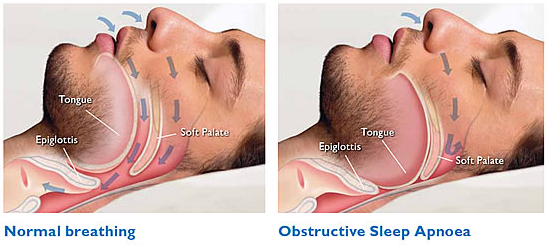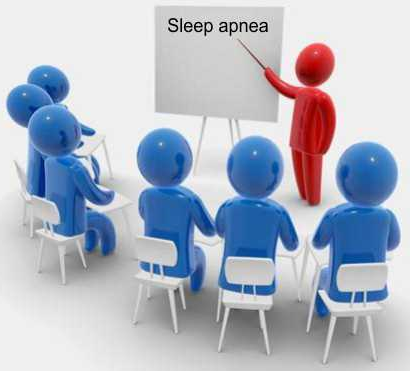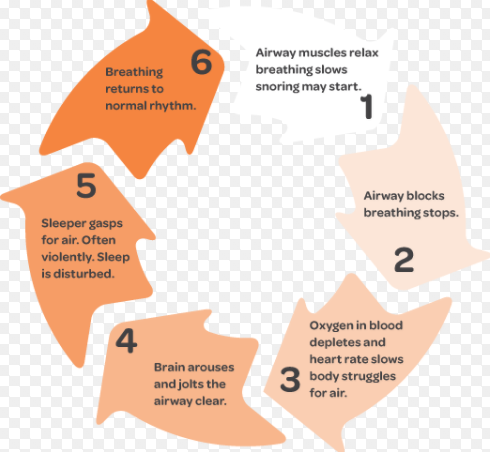
Sleep apnea is a common, serious sleep disorder characterized by consistent interruptions/pause in breathing during sleep. It is adversely affecting millions of population worldwide.
Understanding sleep apnea


An individual can have obstructive sleep apnea, central sleep apnea or features of both.
Obstructive sleep apnea:
Obstructive sleep apnea is the most common form. It develops due to blockage of the airways. Air has to go from the nose through the nasopharynx into the laryngopharynx, through the larynx then into the trachea.
Somewhere along that path there might be a blockage in the flow of air due to:
- Allergies: might cause swelling in the tissues of nasopharynx
- Swollen adenoids/tonsils: due to infection
- Severe underbite: pulls the jaw back & blocks the airway
- Overweight: in individuals those are overweight there could be too much weight in the soft tissues of the neck, which can weigh down the airway especially when a person is lying down.
- Hormonal changes: at night cause the muscles around the airway to become slightly less stiff while sleeping. This means that they are less able to keep the airway open, making it more likely to get a bit squashed or obstructed.
Central sleep apnea:
Central sleep apnea refers to the fact that the problem is “central” or related to the central nervous system. This is where the brain intermittently stops making an effort to breathe for 10-30 seconds.
The apnea can persist for several seconds even after waking up, triggering feelings of panic & further disrupting the sleep cycle.
Central sleep apnea starts with an initial episode of hyperpnoea, which is when the brain directs the lungs to start hyperventilating during sleep by increasing the respiratory rate.
This rapid breathing causes hypocapnia, a drop in the blood’s carbon dioxide levels. When the CO₂ falls below a certain threshold, the body slips into a state of apnea, making no effort to breathe & taking in no oxygen. This causes CO₂ levels to rise back to normal levels & then, as the apnea persists, they keep rising to which is called hypercapnia.
The really high CO₂ levels triggers hyperpnoea again, & the cycle starts all over.
Essentially, the respiratory system is going rapidly back & forth between two states, first making no effort to breathe & then hyperventilating, with no-in between.
Symptoms of sleep apnea
The most common symptoms of sleep apnea include:
1) Severe sleep deprivation: interrupted sleep can cause:
- Nocturia & stress induced insomnia.
- [Nocturia: the excessive need to urinate during the night.]
- Difficulty concentrating
- Headaches
- Fatigue
2) Worsen other health problems:
- Drops in oxygen levels can trigger anginal chest pain, & can irritate heart cells leading to an arrhythmia—an irregular heartbeat.
- Higher risks for heart failure, respiratory failure, diabetes & certain types of cancer.
How to diagnose sleep apnea
Diagnosing sleep apnea requires a sleep study to help identify episodes of sleep apnea, the more episodes the more severe the sleep apnea.
A sleep study usually involves getting monitored overnight with a polysomnogram. A polysomnogram tracks things like brain movement, oxygen & CO₂ blood levels, vital signs, & outward symptoms like snoring & movement.
Treatment
Treating sleep apnea starts with avoiding things like sleeping pills, alcohol, & other depressant medications because they can relax the throat muscles around the airway & make the airways more likely to collapse during sleep.
In addition, sleeping on the side instead of on the back can also help because it creates better airflow into the lungs.
For severe sleep apnea, individuals can use a continuous positive airway pressure device or CPAP device for short. This machine forces the airways open with a steady stream of pressurized air delivered through a plastic facemask or nasal prongs. Used properly, this is very effective, but it requires continuous use.
Many people eventually stop using it, finding it annoying or difficult to wear, & the problem persists.
Some people with obstructive sleep apnea can benefit from custom made oral appliances that help improve airflow & prevent upper airway from collapsing during sleep. Sometimes, obstructive sleep apnea can be managed surgically, for example removing large adenoid tissue or realigning the jawbone.
So, summing it up sleep apnea can be due to physical obstruction of the airway or from a neurological malfunction initiated by imbalances in the blood’s oxygen & CO₂ levels, which regulate breathing cycles. Left untreated, the condition can interact negatively with other underlying health conditions, leading to serious complications. If you think you are suffering from this problem, schedule an appointment at Dental Implant India.





